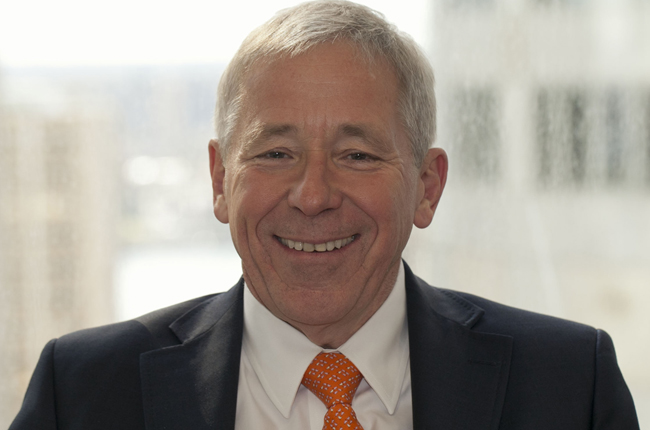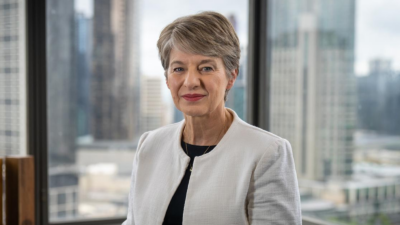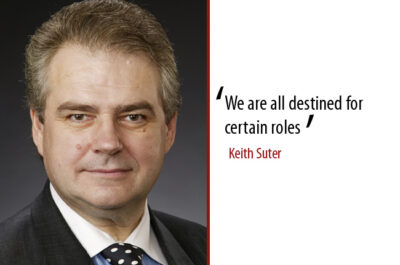My career, my industry – a journey around the world
Trevor Matthews … ‘what I’ve decided is I now want to be a superb director and chairman’
The story of Trevor Matthews’ long and illustrious career in life insurance and investment markets is, in a way, a reflection of the evolution of those markets over the past 35-or-so years. Now a non-executive director of several companies, who remains a fellow of the Institute of Actuaries in both Australia and the UK, Matthews spoke with Greg Bright about all the changes along the way.
When Trevor Matthews accepted an actuarial cadetship from Legal & General in Australia on leaving school he didn’t expect to stay with the firm for 26 years, rising to head up its Australian operations before going on to bigger things elsewhere, in Canada, Japan and the UK. Back then, up until the 1980s, life insurance was bundled: it was a whole of life and endowment assurance market. Splitting insurance from investments was to have a knock-on effect throughout the insurance and funds management industry.
As he recalls, it was Australian Eagle, a subsidiary of the UK based Eagle Star, which introduced unbundling to Australia. In doing so, Matthews says, it became clear where the big charges were being made, with commissions of between 150-200 per cent of first-year premiums being paid to agents. He believes that commissions are still high on risk products, but not anymore on savings and investment products.
“As an investment proposition, it just didn’t stack up,” he says. The unbundling was followed by a period of rapid product development, as Australian firms imported ideas from offshore and other overseas companies entered the market.
In the previous decade Occidental Life, from the US, had shaken up the staid Australian life insurance industry by introducing yearly renewable term insurance, with premiums increasing with rising age and encouraged clients and agents to “buy term and invest the rest”. Matthews observed that yearly renewable term never took off in the UK. He believes the product is somewhat flawed because its structure encourages churning. A healthy customer can shop around for replacement cover year after year and the increasing premiums become unaffordable. This poor product design is one of the reasons for the lapse problems we are seeing with term insurance today.
“The next big thing I remember,” he says, “was the introduction of unit linked business and single-premium products, such as insurance bonds, which were successful in the UK but new to Australia.”
For the first time, in the early 1980s, Australian institutions were allowed to offer unit-linked products, following the appointment of an industry professional, Tig Melville, to the role of Life Insurance Commissioner overseeing the industry. His predecessor, Sid Caffin, had not allowed it and it proved to be a steep learning curve for the Australian market. By that stage Matthews was a qualified actuary.
“I was sent to the UK to learn [about unit-linked products] and then I came back to Australia as L&G’s chief actuary, at the age of 30.” When L&G introduced its first unit linked product, a property fund, Matthews remembers, the executives gathered around the board table and debated what price the units should be – it was complicated. Contrast that to the situation today when many life companies calculate and publish hundreds of prices every day. Weekly pricing on some products also caused problems with some companies getting into trouble especially after the market crash of 1987. He also remembers being reprimanded by the Institute of Actuaries of Australia for writing a letter to the editor of the Australian Financial Review, with his L&G colleague Peter Smyth, which was critical of the Australian superannuation system. At the time, before Award Super was introduced in 1986, there were big tax breaks with super but only about 45 per cent of workforce coverage.
L&G in Australia weathered the 1987 crash and Matthews became its CEO in 1989, which happened to coincide with a big jump in popularity for capital guaranteed investment products, particularly from the embryonic industry funds. It was also a time of high inflation and high interest rates.
He says: “The big mutuals competed aggressively offering high capital guaranteed crediting rates to industry funds. This rapidly siphoned off a lot of the reserves they had steadily accumulated over the past hundred years. They were probably hopeful that they could get other [more profitable] mandates from the industry funds. We started to worry about the guarantees we were giving and then I was told, by London, to stop doing it, even though all our competitors were. So we faced up to the issue and explained why we were deliberately limiting sales and so dodged that bullet. It’s another time we led the industry.” The period was followed by “the recession we had to have” (Paul Keating) and capital guaranteed products largely fell by the wayside.
By the mid-1990s, the writing appeared on the wall for the Australian subsidiaries of a number of foreign-owned life offices, including L&G. Matthews says he spent a lot of time trying to persuade London not to sell the Australian business, but this was to be to no avail. Along with the likes of Prudential and Friends Provident, L&G exited Australia in 1998, two years after he left.
Matthews went to NAB for a couple of years to run the bank’s retail banking business and its life company and associated businesses, which he describes as “great fun”. He was then head-hunted away to Canada, for what he thought would also be a relatively short time. He ended up staying overseas – Canada was followed by Japan, Edinburgh and then London – for the next 15 years before returning to Australia only last year.
L&G was a pioneer in Australia in many product categories, in both insurance and funds management. It was one of the first mainstream fund managers to introduce indexing and also came up with the term ‘art and science’ for the blend of quant and fundamental research in investment management.
“In 1980, I went to the US and saw that the Surgeon General there had come out strongly against smoking. I rushed back home and L&G subsequently became the first company in Australia to offer significant discounts to non-smokers. All the other life companies followed except for Australian Eagle which at that time was owned by the tobacco manufacturer, BAT.”
The Japan experience for Matthews was a challenge with all sorts of cultural and other issues at Manulife, which had been “thrown out” of Japan during WWII and struggled for a long time after to rebuild a foothold. Matthews was headhunted then to Scotland with Standard Life and headed up their UK business, which was 70 per cent of the company’s revenue. It was there that he introduced the firm’s wrap platform and had the audacity to choose a little-known New Zealand company, FNZ, to build it. FNZ has gone on to be a big player in the investment technology game in several countries including Australia and Matthews is now a non-executive director of its Australian subsidiary.
Matthews continued his foreign tour of duty in the UK moving from Edinburgh to London to become group CEO of Friends Provident, which was another successful turnaround and was subsequently taken over by Clive Cowdery’s Resolution plc. His last overseas role was as a main board director and in charge of Aviva’s large UK life and general insurance businesses. The arrival of a new group CEO after a strategic review at Aviva worldwide gave Matthews “the opportunity to continue my journey back to Australia”.
Back home, and apart from building a new house overlooking Balmoral Beach in Sydney, Matthews has gathered an impressive line-up of non-executive directorships. In March this year he was appointed to the main board of AMP Ltd and then the boards of AMP Life and National Mutual Life. He joined the board of the listed Cover-More Group Ltd late last year, has become a director of health care group Bupa Australia and NZ and FNZ, which is chaired by former Labor Senator, Nick Sherry. He retains a Japanese connection as an advisor to Tokio Marine Holdings. Interestingly, Lord (Sandy) Leitch is the chairman of both BUPA and FNZ’s UK boards.
“Being on boards is a big transition for me,” Matthews says. “What I’ve decided is I now want to be a superb director and chairman. I’m enjoying very much settling the family back here in this great country.”










